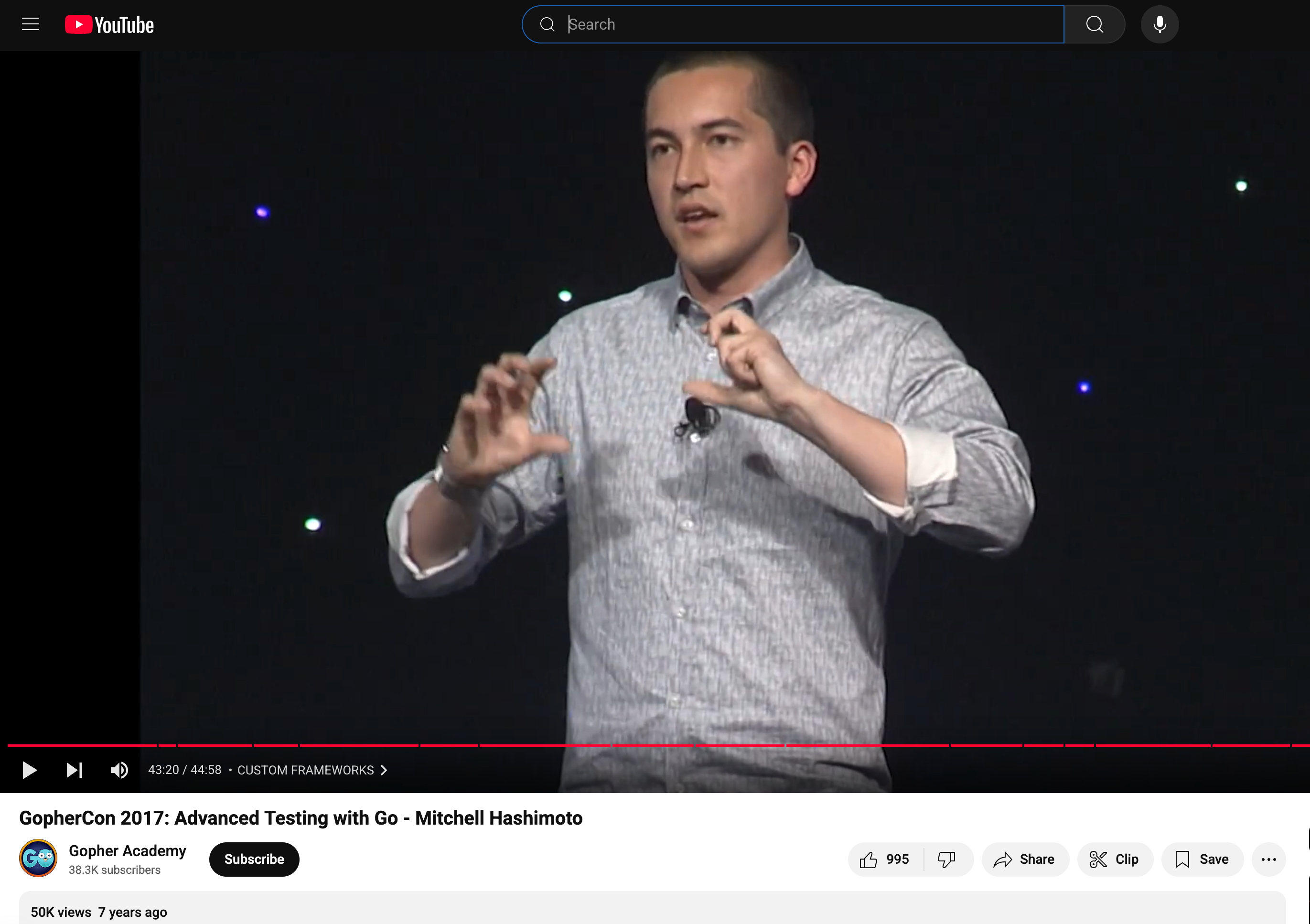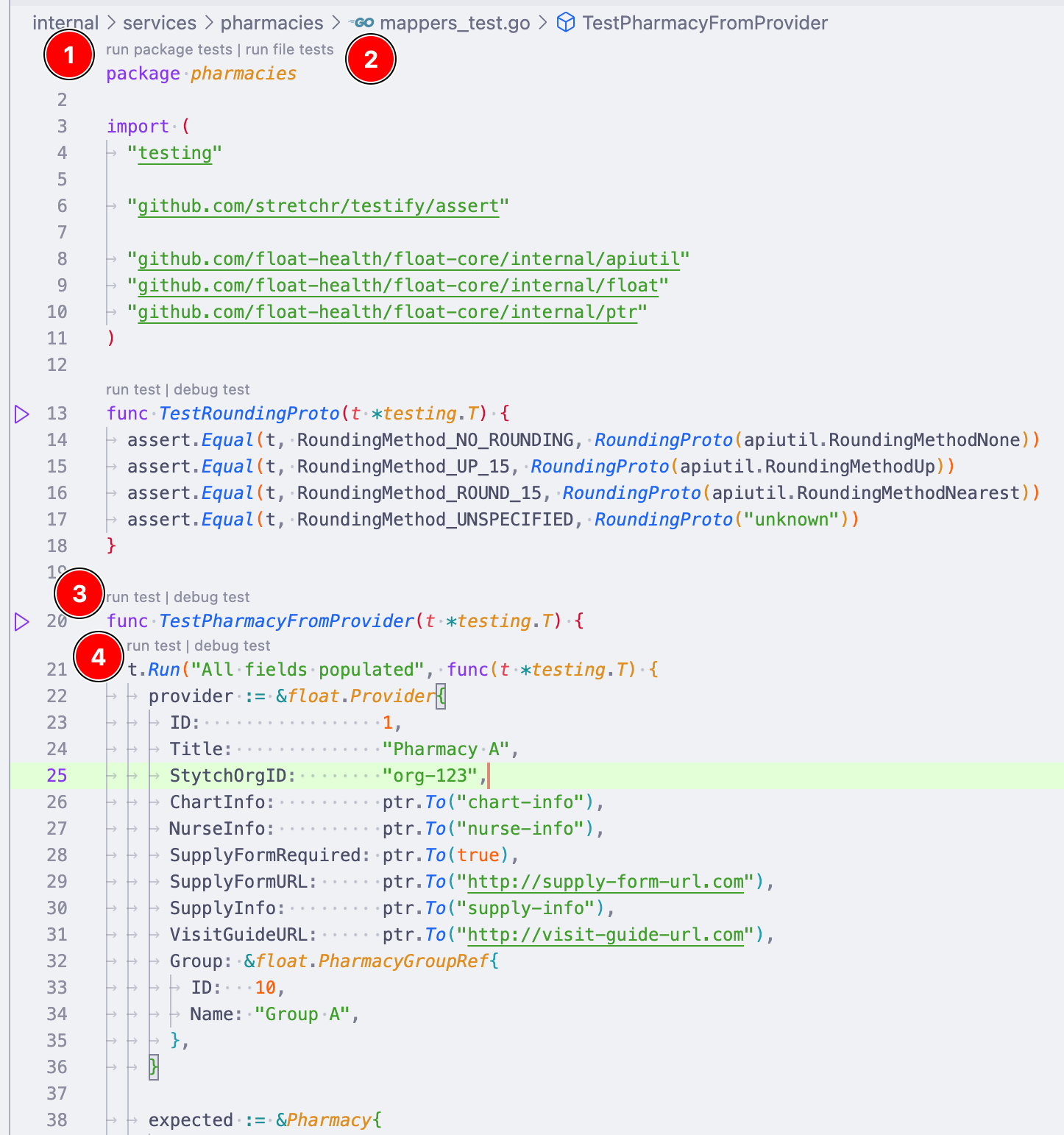go testing with f-tests
Mile High Gophers
May 2025
Too Long; Didn't Watch
Blog post
f-tests as a replacement for table-driver tests in Go
by Aliaksandr Valialkin
Who's this?

table-driven tests
- a widely-used pattern in the go community
- documented on the go wiki
- used in the standard library
- blogged about by Dave Cheney
table-driven test example (stdlib slices)
var indexTests = []struct {
s []int
v int
want int
}{
{
nil,
0,
-1,
},
{
[]int{},
0,
-1,
},
{
[]int{1, 2, 3},
2,
1,
},
{
[]int{1, 2, 2, 3},
2,
1,
},
{
[]int{1, 2, 3, 2},
2,
1,
},
}
func TestIndex(t *testing.T) {
for _, test := range indexTests {
if got := Index(test.s, test.v); got != test.want {
t.Errorf("Index(%v, %v) = %d, want %d", test.s, test.v, got, test.want)
}
}
}f-test example
func TestLogfmtParser(t *testing.T) {
f := func(s, resultExpected string) {
t.Helper()
p := getLogfmtParser()
defer putLogfmtParser(p)
p.parse(s)
result := MarshalFieldsToJSON(nil, p.fields)
if string(result) != resultExpected {
t.Fatalf("unexpected result when parsing [%s]; got\n%s\nwant\n%s\n", s, result, resultExpected)
}
}
f(``, `{}`)
f(`foo=bar`, `{"foo":"bar"}`)
f(`foo="bar=baz x=y"`, `{"foo":"bar=baz x=y"}`)
f(`foo=`, `{"foo":""}`)
f(`foo bar`, `{"foo":"","bar":""}`)
}testing workflows
CLI
go test ./...for everything- or filter using package names and test name substrings
go test ./... -run="MyTest/my subtest"IDE inline buttons
- VS Code: "Run Test" & "Debug Test"
What do you do?

my struggles with table-driven tests
- yo-yo reading
- defeats breakpoint
- often brings in anonymous structs
- failure line number is always inside the loop
- not the line with the unexpected data
things I don't really want in my tests
- anonymous structs
- especially before I've read the code that uses them
- maps with names as keys
- big inline data structures
- loops
- extra nesting

table-driven: can't breakpoint the broken case
for _, tc := range tests {
t.Run(tc.name, func(t *testing.T) {
got := strings.Index(tc.s, tc.substr) // BREAKPOINT here sucks
if got != tc.want {
t.Fatalf("unexepcted n; got %d; want %d", got, tc.want)
}
}- can run a single case by name with CLI though!
f-tests breakpoint a particular case
f(`foo=bar`, `{"foo":"bar"}`)
f(`foo="bar=baz x=y"`, `{"foo":"bar=baz x=y"}`)
f(`foo=`, `{"foo":""}`) // BREAKPOINT here is fine
f(`foo`, `{"foo":""}`)f-test basic pattern
f := func(arg)...at top- inside
f()callt.Helper() - do arg preparation, call real code, assert results
- each case is a call to
f() - separate tests for success cases & failure cases
f-test nicities
- test code comes before suite of cases
t.Helper()used properly to indicate correct line number on failure
f-tests meh
- separate top-level test functions for success vs error cases
- can't run a single case by name with CLI
test code should be clear and easy
- we are by definition surprised or confused when tests are failing
- it's hard enough to understand the code itself
both meh
- commenting out code temporarily sometimes seems unavoidable
meta: don't defeat the tooling
The End
peterlyons.com
bluesky: @peterlyons.com

Backup Bonus Slides
SQL Update 1
UPDATE user SET
first_name = "Bob",
last_name = "Roberts",
eye_color = "blue",
shoe_size = 10.5,
tag_line = "Ziggity Zoop"
WHERE id = 777;SQL Update 2
UPDATE user SET
tag_line = "Bim Bam Boom"
WHERE id = 777;Relational DBs
- support
NULLand use it heavily in practice - support partial updates and that's the dominant data edit pattern
JSON
- supports
null - dynamically typed
- supports omitting properties
go structs
- fixed set of fields
- no way to express subsets of fields
- can't express both "set this field to nil" and "do not alter this field"
full update paradigm is 👎
- likely to cause accidental overwrites of new data with old data
What are the semantics behind the "age" property in each message below?
{"age": 27}{"age": null}{"name": "Betty"}
solution is wrapper struct
This becomes a problem when interoperating with languages that have an explicit way to have a struct or object value be undefined or unset. Go maps have this property, a key either exists or it does not exist in the map, but a Go struct field always exists. Despite this problem in order to avoid completely unstructured data, gain a modicum of type safety and minimal validation it's generally still recommended to use a struct when writing in Go.